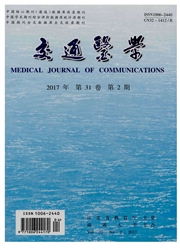

 中文摘要:
中文摘要:
目的:建立大鼠运动病前庭习服模型,探讨前庭习服行为过程中神经细胞可塑性和学习记忆的参与及其可能的机制。方法:以条件性厌食症作为大鼠运动病评价指标,通过持续锻炼获得大鼠前庭习服模型。采用免疫组织化学法观察正常组、模型组和习服组鼠脑内前庭核与海马部位c-Fos表达的情况。结果:采用Crampton旋转刺激装置进行连续锻炼,隔日1次,每次30min,连续28d的旋转刺激后,可明显提高大鼠对运动病的耐受力,产生习服。免疫织化学法结果显示,旋转刺激可以引起前庭区c-Fos阳性神经元的数量增多,习服后下降。但海马脑区c-Fos免疫标记阳性细胞数目习服后仍然维持在高水平。结论:海马脑区细胞和前庭核团的可塑性变化参与了大鼠对前庭刺激的耐受。
 英文摘要:
英文摘要:
Objective: To establish the rat motion sickness habituation model and to observe possible involvement of neuronal plasticity, learning and memory in motion sickness habituation. Methods: The motion sickness model of condi- tioned taste aversion (CTA) was used to evaluate the extent of habituation in rats obtained through sustained vestibular ex- ercise. Expression of c-Fos was observed at the vestibular nuclei and hippocampuses of different groups of rats with or without habituation after vestibular stimulation by using immunohistochemical methods. Results: The motion sickness ha- bituation was modeled successfully through repeated rotation (30 min every other day for 28 d) on Crampton stimulated-de- vice. Immunohistochemistry study revealed the temporal increased c-Fos immunolabeled neurons in the vestibular nuclei of rats exposed to 30 min rotation, which was followed by a decline back to the baseline level after repeated trainnings. Unlike vesitibular nuclei, quantified c-Fos positived hippocamal neurons showed an increase tendency after vestibular stimulation, especially in rats with continuous rotation every other day. Conclusion: These results suggest that the change of neuronal plasticity in the vestibular nucleus and hippocampus might contribute to attenuation of motion sickness symptoms and vestibular habituation process.
 同期刊论文项目
同期刊论文项目
 同项目期刊论文
同项目期刊论文
 期刊信息
期刊信息
